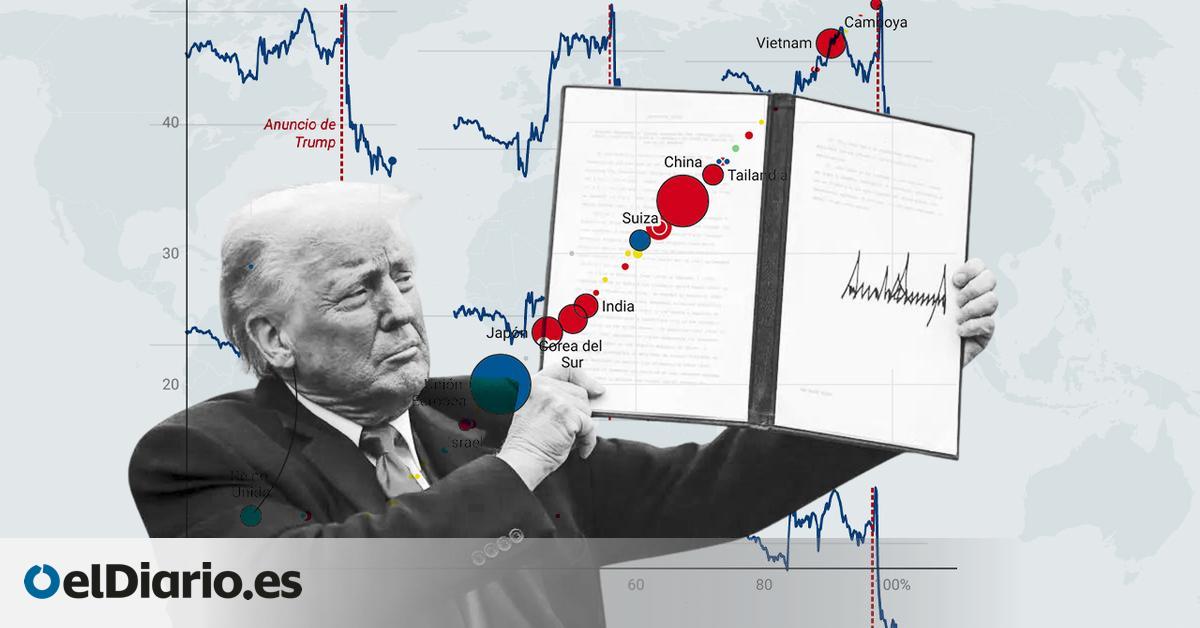
“For Americans it is not the day of liberation, but the day of inflation,” said Economy Minister of Germany, Robert Habeck on Thursday. The rebound of prices increases is one of the main consequences of the total commercial war escaped by the president of the United States, Donald Trump, with his aggressive tariff policy. But this threat is not only for consumers of the first world power, it is also for the rest of the countries, including the European Union (EU) and Spain.
Inflation is not the only risk facing the global economy. The kick that Donald Trump has given to the World Commercial Board has already caused Milmillionaire losses in the stock market, a drop in the dollar and has made all the alarms of recession and destruction of jobs jump due to the direct coup of export tariffs and indirect damage to the activity in general, starting in the United States and passing through Germany, France, Italy and our country.
“A world in Limbo,” S&P Global titled his last exercise of economic forecasts only a few days ago. The “extreme” uncertainty – as the governor of the Bank of Spain, José Luis Escrivá – is described, is the third irremediable consequence of the commercial war. Many sectors and companies and also governments and other institutions such as central banks are obliged to reassess their decisions, find new customers or transfer production; to design aid as those already announced by the Executive of Spain; OA to rethink policies such as the declines of the interest rates of recent months, respectively.
Tariffs and inflation
“Reciprocal ‘tariffs [según la retórica de que Estados Unidos sufre un trato injusto de sus socios y adversarios] They are an important part of the reason why Americans voted for President Trump: they were a cornerstone of his campaign from the beginning, ”says Wednesday’s statement in which the White House announced the tariffs to the rest of the world [del 20% al conjunto de la UE]. “Everyone knew that he would press to achieve them once he returned to office; it is exactly what he promised and is a key reason for which he won the elections. These tariffs are fundamental for President Trump’s plan to reverse the economic damage left by President Biden and put the United States on the road to a new golden era,” continues this document.
What Donald Trump cannot hide is that tariffs directly make imports in the United States. Therefore, they raise the costs of the companies and, ultimately, they are transferred to the prices paid by consumers, families, also their voters. Donald Trump’s alleged background to relocate the different industries and stop depending on exterior goods and services implies deep changes in production systems and value chains that run through the world, and that in no case are immediate, or painless.
The first proof of self -inflicted damage by the United States with tariffs is in the heart of financial markets, on Wall Street, where the red with which sales sales and losses have been extended by all screens.
In the graph, the millmillional losses of the most capitalized companies in the United States, the large technological companies, can be observed. Investors are getting rid of their mass shares because Apple’s business could suffer the consequences of Donald Trump’s tariffs —Mayores costs, falling sales if other markets respond with more tariffs …—, Because Alphabet (Google) or Microsoft could suffer regulatory reprisals or specific taxes on their benefits or because the dominant position of Amazon could be questioned in many countries.
Other business symbols in the United States, such as Nike, which manufactures the largest of its products in Asia, are directly threatened and their actions have collapsed in the last hours, although the White House insists that “the tariffs work”, and defends that they benefit “the workers” of the country. “Studies have repeatedly demonstrated that tariffs can be an effective tool to reduce or eliminate threats that harm the national security of the United States and achieve economic and strategic objectives,” says its statement on Wednesday.
The VX or index of the ‘fear’, which measures the volatility of the S&P 500 – the selective Wall Street (brings together the 500 largest contributed companies in the United States) -, serves to identify the uncertainty peaks of the last weeks. The same that happens with the abrupt fall of profitability (the interest rate) offered by the United States debt in the secondary market, as a reflection of the purchases of this ‘safe’ asset or ‘shelter’ (in financial jargon) given the risks of the majority of companies in the country.
In the EU, the first blow is exports to the first world power. For example, the Chamber of Commerce of Spain advanced Thursday that tariffs will reduce about 15% exports from our country. This damage is much greater for Germany or Italy.
“Every day they move between one side and another of the Atlantic 4.4 billion euros in trade of goods and services. This is what we have to protect. There is much to lose if we do not negotiate. If we do not reach an agreement, the risk is very large. That said, of course we are not going to be naive. We have the necessary tools to respond and we will do it if necessary,” the Minister of Economy, Carlos body, affected this Thursday, Carlos’s Minister. The European Commission keeps conversations with the White House. Meanwhile, he designs a protection shield and a phase response, which would start with aluminum and steel tariffs on Wednesday, April 9.
Carlos body has been remembering that Spain is less exposed than other community partners, although it does not deny the “indirect” impact. “That is, the connection with the rest of the EU countries, which can have more exposure. We are all interrelated and, therefore, we will finally have to see how this impact is transmitted, which in the end will also be different according to the sectors,” he said.
The final European response to the new Donald Trump tariffs will be known in the next few days. A business rates policy back to all imports from the United States would replicate the internal consequences of this policy in European countries: raising inflation, and, therefore, hitting the purchasing power of families – as we know well after the last years of price increases; and threatening economic activity in general, in a context of special weakness in Germany, whose economy has remained stagnant in recent years.
Risk of stagnation in the Eurozone
“The level of uncertainty we face is exceptionally high,” the president of the European Central Bank (ECB), Christine Lagarde, regretted at the beginning of March, at the twenty -fifth conference ‘Ecb and ITS Watchers’ [el BCE y sus observadores, en inglés]. “The certainties established on the international order have been disrupted. […] We have witnessed unthinkable political decisions just a few months ago, ”he continued.
A few days later, before the Commission for Economic and Monetary Affairs of the European Parliament, Lagarde warned that the commercial war “is evolving, and any estimate is subject to considerable uncertainty.” Although he dared to point out that “the ECB analysis suggests that an 25% American tariff on imports from the EU would reduce growth [del PIB] of the Eurozone by approximately 0.3 percentage points during the first year. “In addition,” a European response consisting of increasing tariffs on US imports would further increase this figure, up to approximately half a percentage point. “The provision of progress of the GDP (Gross Domestic Product) of the whole of the euro partners is currently of a meager 0.9%, in 2025 after the cut of two tenths in the beginning of March of 1.1%.
“Most of the impact on economic growth would be concentrated around the first year after the rise in tariffs; subsequently, it would decrease over time, leaving, however, a persistent negative effect on the level of production,” explained the president of the ECB. “Allow me to emphasize again that these estimates are subject to very high uncertainty, since the impact of tariff increases can be non -linear, for example, due to a significant reconfiguration of global supply chains. Of course, the high level of political uncertainty forces us to stay alert and prepared to act and protect price stability,” he concluded.
Interest rates and exchange rate
The BCE president recalled that, at the beginning of last month, “we reduced our key interest rates in another 25 basic points [al 2,5%]. Inflation is being developed, in general, as planned, and most underlying inflation indicators suggest that it will stabilize around our medium -term target of 2% in a sustained way. ”
“The interest rate of the ease of deposit is currently at 2.5%, 150 basic points below the maximum of 2024. Our monetary policy is becoming significantly less restrictive. The new credit is being reduced for companies and homes, while the growth of loans is accelerating,” he said. But the key is as follows: “We do not compromise previously with a path of specific interest rates,” he concluded.
Monetary policy could change the step again to an increase in inflation, and on this the evolution of the euro/dollar will depend. Currencies play a crucial role in commerce. The depreciation of the euro with respect to the dollar implies that eurozone companies sell cheaper to the United States, being able to cancel part of the effect of tariffs. At the same time, imports, for example energy (specifically oil), pressing up rising inflation. In the last hours, the opposite is happening: a depreciation of the dollar.
Source: www.eldiario.es

